
Ask the Experts: Helping Your Student Athlete Avoid Common Injuries
As parents, the importance of your child’s safety and well-being is always top of mind. When your child is involved in athletics, safety is especially important regardless of the age or level of competition. Whether they’re sprinting across the soccer field, leaping over hurdles, or going all out on the basketball court, young athletes face the risk of injury with every game and practice session. Our CaroMont Health Athletic Trainers work in our local high schools with the same mission as you: keeping your student healthy and strong, both on and off the field. In this blog, they will share their best tips for encouraging smart habits that can help safeguard your child’s health and prevent common sports-related injuries. From warm-up routines to proper technique and everything in between, they’re here to empower you with the knowledge and tools needed to support your young athlete’s journey to success while prioritizing safety above all else.
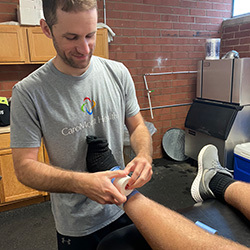
Ira Fowler – Cherryville High School
Start with Proper Technique and Form
You wouldn’t build a house on a bad foundation! Proper technique/proper form is the basis for longevity in any athletic endeavor because it is critical to always control weight throughout the range of motion. That can be very challenging with poor technique and form. A good form is the strong foundation necessary for stability, which in turn allows us to generate more power which builds strength.
How do you know if your student-athlete is using proper technique? Request assistance from your child’s athletic trainer. We can work with them and further educate them on how proper technique and form when exercising can fuel their success and support lifelong well-being.
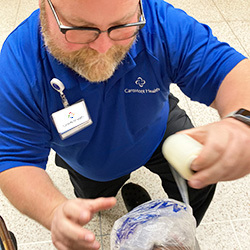
Bill Harvard – Bessemer City High School
Remind Your Student to Warm Up and Cool Down Consistently
Warm-ups get your athlete’s body ready for activity and have been shown to prevent injury. Warm-ups should last five to ten minutes, be easily repeatable, and include motions or activities specific to the activity e.g., jogging, running/cutting, or upper body throwing motions. Encourage a lesser intensity than the activity but should be intense enough to cause a light sweat or heavy breathing, with stretching prior to activity.
A gradual cool-down of five to ten minutes (like walking) will allow heart rate, body temperature and breathing to return to normal. Have your athletic trainer suggest cool-down stretches and proper form (no bouncing and slow/steady breathing). One of the best benefits of a good cool-down routine is less muscle soreness after workouts and games. It will help your child transition back into normal activity and give their body a chance to recover safely.
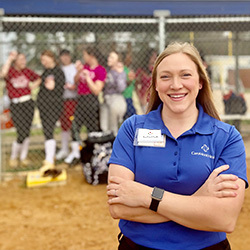
Hannah Braddock – Highland School of Technology
Partner with Your Experts and Communicate
As an athletic trainer, my job is to be a source of expert information for you and your student athlete. Encourage your child to seek out their athletic trainer and keep them informed of any new or recurring aches and pains. Be proactive. By establishing communication with the coach and athletic trainer early when there is an injury or potential injury, we are better equipped to intervene before serious injury occurs. The more information you and your student share with us, the better we can help your athlete avoid issues and/or return to their sport quickly after injury!
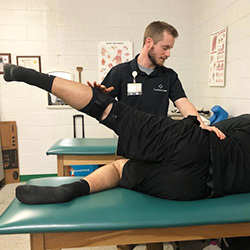
Beau Brown – Ashbrook High School
Encourage Cross Training and Variety in Workouts
If there isn't variety in workouts and training, injuries can occur due to overuse and excessive strain placed on the joints and muscles. We work with athletes every day to ensure that doesn’t happen and that every student is changing their workout routine every so often can help prevent overuse injuries. A different routine can also be mentally stimulating and help reduce the burnout and boredom some athletes face.
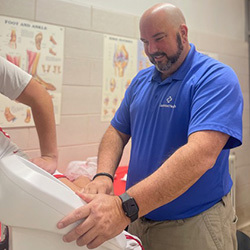
Tomas Chao – South Point High School
Strength and Conditioning is Always Important, No Matter the Sport
Avoiding injury in sports can heavily depend on overall strength and condition. That’s why athletic trainers work with students on and off the field to build strength and improve movement through a variety of techniques. While my job focuses on sports, I believe we are building good habits that can last your student a lifetime. I really focus on core strength as it is the best for overall health. Everything we do starts with our core, building a strong foundation for every sport, but also helping prevent future problems like back pain.

Rachel Toelkes – Forestview High School
Rest and Recovery are Important
Resting is one of the hardest things to do when injured, but it is a vital component to healing and recovery. Not only should you and your child follow the recommendations of healthcare professionals treating the injury, but prioritizing rest is critical. Did you know a teenager's recommended amount of sleep is eight to ten hours? Along with rest from sport, ensuring your athlete gets enough sleep is critically important for the body to recover.
Stress can also be a major impediment to healing. It can be stressful to be an athlete, especially with other obligations like school, social life and competing. Encourage your child to look after their mental health by helping them find activities to take their mind off worries and focus on the current moment. It's so important to give time and space for healing, but also to build good habits that help prevent future injury.
By implementing these tips, you're not only helping your child stay injury-free, but also instilling lifelong habits that promote overall health and wellness. With the right guidance and support, student-athletes can thrive on and off the field. Together, let's continue to champion safe and health sports participation, ensuring your child reaches their full potential.
